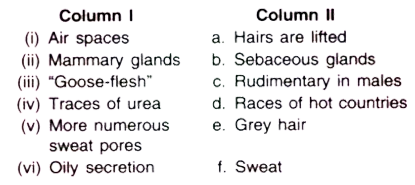Match the items in Column-I with Column-II and choose the correct alternative
Column-IColumn-IIa.Fasciculated storage roots1.Tinosporab.Pneumatophores2.Heritierac.Haustoria3.Asparagusd.Stilt-roots4.Viscume.Assimilatory roots5.Screwpine
a-3, b-2, c-4, d-5, e-1
a-3, b-4, c-5, d-2, e-1
a-4, b-2, c-3, d-5, e-1
a-2, b-4, c-5, d-1, e-3
The correct Answer is:A
To solve the matching question between Column-I and Column-II, we will analyze each item in Column-I and find the corresponding item in Column-II based on the characteristics of the roots and their examples.
1. Fasciculated Storage Roots (A):
- Fasciculated storage roots are characterized by a cluster of tuberous roots.
- An example of this type of root is Asparagus.
- Match: A - 3.
2. Pneumatophores (B):
- Pneumatophores are specialized roots that help in breathing, especially in waterlogged conditions.
- An example of pneumatophores is found in Heritiera.
- Match: B - 2.
3. Haustoria (C):
- Haustoria are specialized roots of parasitic plants that penetrate the host plant.
- An example of haustorial roots is Viscum.
- Match: C - 4.
4. Stilt Roots (D):
- Stilt roots provide additional support and are often found in plants like sugarcane and screw pine.
- An example of stilt roots is Screwpine.
- Match: D - 5.
5. Assimilatory Roots (E):
- Assimilatory roots are green in color and perform photosynthesis.
- An example of assimilatory roots is Tinospora.
- Match: E - 1.
Final Matches:
- A - 3 (Fasciculated storage roots - Asparagus)
- B - 2 (Pneumatophores - Heritiera)
- C - 4 (Haustoria - Viscum)
- D - 5 (Stilt roots - Screwpine)
- E - 1 (Assimilatory roots - Tinospora)
Answer:
The correct alternative is the first option.
---
- Fasciculated storage roots are characterized by a cluster of tuberous roots.
- An example of this type of root is Asparagus.
- Match: A - 3.
- Pneumatophores are specialized roots that help in breathing, especially in waterlogged conditions.
- An example of pneumatophores is found in Heritiera.
- Match: B - 2.
- Haustoria are specialized roots of parasitic plants that penetrate the host plant.
- An example of haustorial roots is Viscum.
- Match: C - 4.
- Stilt roots provide additional support and are often found in plants like sugarcane and screw pine.
- An example of stilt roots is Screwpine.
- Match: D - 5.
- Assimilatory roots are green in color and perform photosynthesis.
- An example of assimilatory roots is Tinospora.
- Match: E - 1.
- A - 3 (Fasciculated storage roots - Asparagus)
- B - 2 (Pneumatophores - Heritiera)
- C - 4 (Haustoria - Viscum)
- D - 5 (Stilt roots - Screwpine)
- E - 1 (Assimilatory roots - Tinospora)
The correct alternative is the first option.
Topper's Solved these Questions
- ROOTBOOK - DINESH PUBLICATION ENGLISHCHAPTER - ROOTEXERCISE - REVISION QUSTIONS FROM COMPETITIVE EXAMS.
52 Videos
- ROOTBOOK - DINESH PUBLICATION ENGLISHCHAPTER - ROOTEXERCISE - Assertion
2 Videos
- RESPIRATIONBOOK - DINESH PUBLICATION ENGLISHCHAPTER - RESPIRATIONEXERCISE - CHECK YOUR GRASP
20 Videos
- SEEDSBOOK - DINESH PUBLICATION ENGLISHCHAPTER - SEEDSEXERCISE - CHECK YOUR GRASP
10 Videos
Similar Questions
Match the items in Columns- I with Column-II and choose the correct option.

View SolutionMatch the items in column I with column II and choose the correct option

View SolutionMatch the items in column I with column II and choose the correct option

View SolutionMatch the items in column-I with those in column-II and choose the correct answer

View SolutionMatch the items in Column I with those in Column II

View SolutionMatch the items of Column I and Column II

View SolutionMatch the items of Column-I with those in Column-II

View SolutionMatch the items of Column-I with those in Column-II

View SolutionMatch the items of Column-I with those in Column-II

View SolutionMatch the items of Column-I with those in Column-II

View Solution
